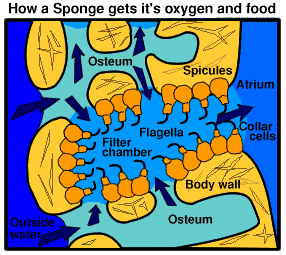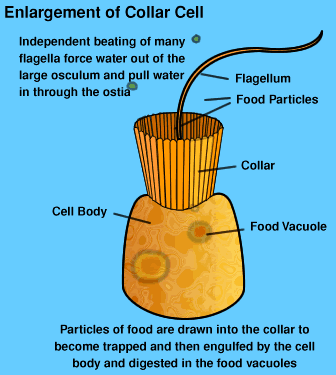|
|
Sponges

The filter chambers are lined with collar cells. Each individual collar cell has a single whip-like flagellum, which beats in a rhythmic manner. The coordinated beating of the combined flagella force water through the sponge. As food particles pass the collar, the small particles become trapped, where they are engulfed by the cell body and digested within the food vacuoles.

Sponges vary greatly in shape and colour depending upon their habitat, water currents and depth. The only way researchers can identify relationships is by looking at small microscopic hook-like spicules which form part of the sponge body wall skeleton.
References:
Bennett, I. (1987) W.J. Dakin's classic study: Australian Seashores. Angus & Robertson, Sydney.
Davey, K. (1998) A Photographic Guide to Seashore Life of Australia. New Holland, Sydney.
Edgar, G.J. (1997) Australian Marine Life: the plants and animals of temperate waters. Reed Books, Kew.
Quinn, G.P., Wescott, G.C. & Synnot, R.N. (1992) Life on the Rocky Shores of South-Eastern Australia: an illustrated field guide. Victorian National Parks Association, Melbourne.
Marine Research Group of Victoria (1984) Coastal Invertebrates of Victoria: an atlas of selected species. Museum of Victoria, Melbourne.
Niesen, T.M. (1982) The Marine Biology Coloring Book. Barnes & Noble, New York.
Home
Page
Taxonomy
Biogeography
Rocky Shores
Tidal Levels
Intertidal Zonation
Environmental Factors
Biological
Factors
Feeding Relationships
Activities
Glossary
References
 Life
on Australian Seashores
Life
on Australian Seashores
by Keith Davey (C) 2000
Learning Consultant
- Media
The University of Newcastle
email at australian_seashores@hotmail.com
Scientific Consultant: Phil
Colman
site created 01.01.98 : updated 01.04.2000
